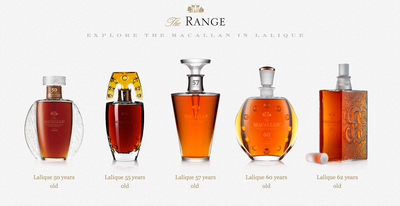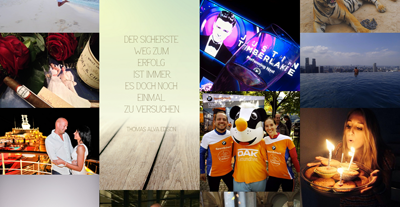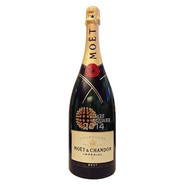Balvenie beat out other high-end scotches and Patron rose to the top of tequilas in the latest Luxury Brands Status Index 2014 from The Luxury Institute.
The "Top-Shelf Toasts: Wealthy Consumers Reveal Preferences Among Champagne And Liquor Brands In Luxury Institute Survey" aims to identify which brands are rising and which brands are sinking. New or reconceived brands are a source of continual disruption for established brands, as millenials are much more open to browsing the liquor and Champagne markets without transcribed loyalties.
"The dynamics of the liquor industry are very disruptive," said Milton Pedraza, CEO of The Luxury Institute, New York.
"The survey should come as a realization and warning to established brands that there is a lot of flux and a lot of up-and-comers that are quickly becoming dominant players," he said.
"Millennials are willing to try new products and are extremely open to adopting new brands for longtime loyalty very quickly."
The survey is a part of the Luxury Brand Status Index series and gathered opinions of eight high-end Champagne brands and 29 liquor brands from four categories. Twelve hundred respondents age 21 and older that have an average income of $282,000 and net worth of $3 million participated.
The LBSI is calculated by averaging each brand’s scores on five separate components of status that relate to premium spirits: quality, taste, packaging, worthiness of a premium price, and appropriateness as a gift. Respondents also reveal total spending on high-end spirits, as well as personal history with particular brands and the brand that they will most likely buy next.
Eroding walls
Mr. Pedraza said that there are several reasons why newcomers can swiftly break through the ranks of brands that have been around for centuries

The Macallan in Lalique collection as of October 2013
First, many young brands are catapulted by celebrity endorsements that have sway among younger consumers.
Also, newer brands are more pliable when it comes to adopting new social platforms and experimenting with technology. However, brands entrenched in history are also showing a canny understanding of social media.
For instance, Spirits maker Moët & Chandon, founded in 1743, positioned itself as the Champagne of choice for celebrations with a global photography contest through Nov. 9 that spanned Instagram, Tumblr and Twitter.

Campaign submissions
The #MoetMoment campaign called for fans to submit photos of any celebration and each week a participant won a golden magnum bottle of Moët Impérial. Since the campaign dispensed prizes on a weekly basis, it may have captivated fans consistently enough to reposition the brand (see story).
Another explanation that Mr. Pedraza cited was the decreasing capital required to start a brand. Therefore, more players are entering the scene. These new players are sometimes steered by millennials keenly attuned to consumer preferences.
Established brands do have much larger media budgets, though, which grants them much greater leeway.

Jeff Koons’ original Balloon Venus for Dom Perignon
Champagne brands that were covered in the survey include Cristal, Dom Pérignon, Domaine Chandon, G.H. Mumm, Moët & Chandon, Perrier-Jouët, Champagne Taittinger and Veuve Clicquot.
Scotch brands included Balvenie, Chivas Regal, Dewar's, Glenfiddich, Glenlivet, Glenmorangie, Johnnie Walker Blue and Macallan. The tequila brands listed were 1800 Reposado, Cabo Wabo, Corazón, Don Julio, Herradura, Jose Cuervo Reserva, Patrón and Sauza Tres Generaciones.
Other luxury liquors addressed in the survey were vodkas and gins.
New normal
Many luxury liquor and Champagne brands have recently enacted campaigns that diverge from conventional tactics to polish their image.
For instance, Krug Champagne is enhancing the sensory experience of its enthusiasts with a shell-shaped listening device designed to amplify the sounds of the spirits’ bubbles to create a new sensation for drinkers.
To introduce the Krug Shell, envisioned by French designer Ionna Vautrin, the Champagne brand developed a Krug Sounds portion of its Web site that accompanies enthusiasts on a unique experience as they learn the concepts behind Ms. Vautrin’s design. Krug’s digital explanation of the Krug Shell will help consumers better understand the thought process and inspiration of the Krug Sounds campaign when using the listening device at home (see story).
Also, French spirits maker Moët & Chandon is using a new approach to sell its Champagne, putting its bottles behind glass in a vending machine.
The vending machine is part of the holiday gift section at British department store Selfridges, and dispenses mini bottles of Moët & Chandon. By putting its product in such an ordinary display, the brand is making itself more accessible and appealing to entry-level holiday shoppers (see story).
However, the influx of new brands changes the landscape.
"Today you are seeing that a lot of other brands, a lot of innovation," Mr. Pedraza said. "It really sends a warning signal to established brands that they need to stay relevant with millennials."
Final take
Joe McCarthy, editorial assistant on Luxury Daily, New York
{"ct":"pPJH6OOVSn7XxDwc6KwVWxITfcsbSvV93MHA+nQPJYUoMSKThY6ePfO8mzONNoRYOoYWHJqci68MFN74j63vBfW60y\/yl9SDZEHZBnavuF2dFIXdrSJw1eOSWPILNE1oH7lN8qA+7Y9luEY8MF1ww80dUwNUr0+1SflA\/iazagsIVO4oxaHYvqORt5AtwhFRYnpNgdmrfOhkczAd7EkGmb4gmJiBp1hMR4u9N4nOuUomQt60A0ozru5EBWWjM9seeWB2d0cA605PFp+fChQDBvTJD4YA8OqQERB10am4t+T1DN6B90C81YEmlqEzaj+K8\/mBzmBeHe0S\/OZ5JUstldxUulumsdoFy\/HDWBwwb5qmsrOBTUatD+NowcpEl19Eljlk7yCPopnaEl3V0ja7ETkHkmoYVrOgjB0VujaWgFbpEKWTOSPogZ3b\/xqDxEYt3TyOCf8LsFqUlASu9O7o+Yp5MN5pVbSL3mDMfJ8oCE8ut10wL4VNCz6j15gWgbgnElIayBW329IjALtGXcFwkJ9VTY6TR+JK8dHI8wnx72hL0gGkAXJZJ9rbVse6IJIZY1Y28UZxzXQe7vO1lvEkVZHNtMFC0DjR\/\/2PRuOV3lJroFcSlHSkrrCleNXewjEzOWRI17qjAmZUWGekh6NiJlInDLrx9Y4Iea3iRflQ2Vhj9L0AA3HFwtIg2RLquEkVKb+NVbOvFMQjh0\/OaYHqtHr5fyluq\/gDaLb3HjR9yjBo7R9\/x3h4omkL399hxekMbGY13gG4nQPMcSeu54xU2SWih0S5YQ6ma8voCSjzcnF\/bhhmxopUZZZgNDAbUyjTKuADejkWeYpC5s0Acm58JKoOBS9WJnHwDc560l0RcSv0xKURGNIfZ\/nzoec64UOzzdQsW8d6V4NQ84HMBZHf9ec1UlEcE2esQljGf6xemTbwN\/p9727qi6PIFcIqOSE1SePV9wp\/2FsTmcDXY0srpxXhxF3f2tKJfPsS\/3kIPr3yS5iimB8JXrReMJiHbV1q\/0rCVg9LLYLOCZzL8R+c5jdKmwNWd019uYCW9YeZcBqIOc7WvRj5r62rw4gdNX6LeDmRkSjStgkUiNeHDaqAVgLPgx+lAHS3wFwqD3QdcbFf+x3FAp2qDIP9nSttzKcZbc5DIwWYhGDc709+WTqwhSqApw3R+sw4p66h2X4UoquZN6kZu7DEPQu90qLldVu76J00epdmc4RYkv6OSnA7k7SLhP8r87xf8DhvbS9zBtJChR1s8jUVcQ5Z2\/U4rlt8SnrnZLSS6cnBDsBwOBB3BwLNoj7lcOT0zRd\/08xnx3fUMcjT8bJD0GoikwfbvUGJvPKr00WsYKt5a5iRYpOMdBBX5M9LPUtekUo0Q1kNeWqR3Hb\/SzqCfrc4CPlXjfnCzo2qNACp9hrlNWW19v4KRAkNLP\/8Ap7NTMJfhU8zZtA5g8Y4ZI0V3ihzjTCJTMi1s3ICY\/QZYpNHm6wgC6tOQXSrCBOcfjl5GLX0qGYornorFgLrS0NaI+QIvEcdt5BaBxnBuiIDyYJwEhQzKT8WIe5l10lOe50yfLMAzGDL1+mV6Zs+aaXE6irTALP\/0Oe6L1E1AETrpH8nNk5H0z0ryHK3Unv9hi4NtgIQBE9ZBG0\/CY+xT0PMMmTynXcxrOaRdBN8V6TrENVbDlCy+vuOemfTRROjujhEVqkdL8hdNxsJs\/GKgB\/ivLlwAp\/E0MQ8acIgYI5678G+TJFg9RVBTZgLwcsJzk24zyACU\/bvpiDgQEFaw6fZb4SZGA2yOMzNGTwirr6+RMMn1arLRhw52WjpGqy4tairlk4qlzPL3tg6SOnJz5pTX87vH2t9xQqM2Vn0F2zyjAsEuob1JI0XAla5OzEbOXWhlPbRraSLHfsMOnztDLsgEOIJO0T14TRPAj+hMQSbvDEI6eWMZ94nZ+g1Z0eRHAb80Jkohkj8IaZPeqyEKwHNSI88BlhLRmT76bESp5CmMrmwiVxLf20nCd9YRSMy5eisfFn08iBhC1zXlNuFUtw5d3iw6E29n21hKDPkBkqhVu3TNbnBxQNNjM23xG7uXmDP5QDqTY5fA4JVkKHzIQz70tbehTajkmAPw6KGNdXspynqW4JFbUvQNZ3pR1CQWw4Uoj7cMOpv+LAoqco4RxJ7UVBcizDCj5dcR1F+3YuBT0Sgc8KiP+yuLFAmCmOjOnjFLV7NutuHWlUUdYudGwLEg1i4Nzjpt\/WPcOKWu0nScZ4KUoCp3IyQOzjWHSRXQdhrlT32Gedfmc5spRi3inZcUwZ\/WMjicXFdNQUu+ommx9+OzVmjOD8\/mG4wEf6cbfC5VjBECu\/LEAGDGuM+JhTp\/giOXTUUXNlziwRz5QRAINxRTj54JOaPHxYomeUouNGpe\/VrPs6LSzoq1dlSZYkWYr3RuuWN4pWZHONAFbKYpILBAXxqCyMGAa2SZ+8fQmAkS1o3LMt1hvPx3o\/F6BR7RR0XU\/hRjUWN4HMkal165A\/LTJVLHyiPXS+cnYm69b\/yACNtRaBmII+K38PhRD83d6CNjV81L3P1cb\/f1lgXDlYLZvcMycDQU5+UfSmXHM\/lGwrNTS7vn8OJIcr3yL6341vEaATlHKkn6frmPc7O+wOkd0D4BYD1xQ\/F+zr0DjgPsvqvxW1Ld12t+ogSqLJmHh6ZOeaAJ+38pVv18nGdkT8pnfYAP91FSYWX0Anzv6REJAyzhy8C6w1jvDDuSKNenvFmV4mrnx8qivO061Ry6IYdA5uYoVShQLiFBKLlKxvnEuYVv0YaCwIDqTyv7eebcnXmPqe3TVqHKmj0\/BuYd03KJ0ztf5fYl09kDUIwwTMW3BBFeWzzwfxO92S+pnMfJpvYGFFfZSlGrJcwr6NtJqkkS\/Mj1Pw3isQ0iM0wGW9USUHjPCYw3AW9+3SRRgjvJ74OVkze\/1Ed4KOAyaX3Us028vbUQRerwuhTM0KJne4IuZhol+oPkeTEpJ057PH0tLYVkp0d2\/tsQSpEwqCovgMRXPCycXjaOkri\/W69qUThdlcGdm6qF3cul8H6dXorvL8iLN2HGQHBB+pgqGeFqoFt\/K+fSSOuhvbkdCKMOUdXC2bjrex1HjnFjMsoxdk8uT4DX85gIJ0ZdCvc5qgWpMIxX9JbGP1GDRqnNwTn7tf9OiflP3+ikYMlSW1ynUnkPkPXNOwa3MYbmcCUc+GoVVBCjGLwXPa7J6QrQRYKMe7Mii\/ZBVYOHvzno\/vkeFzLheROgfYRGeiJlT7+sUxDnOlNav8xi67YIMZaEeh0\/xV5UEPnZ7Y2ZsPff+5HemSHBSVo57myGgsWytLOihx+Y35Gup3y8SNv0skabD0vviMJonhgx8L4GQ1dXYxpfMZat4pLwV2tr2fW9kadT9dS+U5GhZwWMZ0CzX3+ltNo3IDmbbXl2Qd3KkhWi9cyo0Jht56hyYXI1Gq+oE+2J3rEPYpKjlLxvKOPl4VSA735vDZ55qJWfEq06Q\/t9IHHWx7jBBBUjmfPO+v8NY3VXk5V3sZs8gqPKZLFjgYJxfBU0GaONMZZh8bkC+yPzsZxa6yxznpXb49pRN9DV4zMfYDQQSvlPFZRfc1xqz\/59e4dOeG2BA9gHGoVj1LxccOq0ucp\/FuHwCjluCNYTzmbR1PT7FQyAGpfe6urD3lM8r0n\/eEHQ71Ho9NZyT6XzgsomZkDtiUBQK5N0PDpEka8UK1zjGKSUv4YXuMUcTlkfBtov5E3+eCD0zhFVCzvBeSRWNrY2\/lPbV4NYcIXEDypthkzRwqFXlTtEfrETadAmNsaNM1ec2M9jd5oTfcblourT+oMUpqSgByKZ3arvo39IEv0IoV9VvgjdVtMttbozXTksPb\/5SsFE\/op0qhz\/FL6jL7l3IAHDBQ31dXyV6MZm7UkuDpfC108jEoFUVYYOTvGv8NF9ETWAAiY68WZoEBrrIh\/F0nljoqysRRjPIiW4Mwiako6LW0NnCPOUaEbaPIvrmwl3N8O8aZQcEFAPP2JoWmCv2JnS9G53Hwx2Df+n5MUC\/2yBsmfSEgX9Ug9Am31UbUTRdq9uc+H6gpvHxLvAedquOBbvmIslQLhEZ6qGMjOVIAR4MJw5MUIQQHlRzljcaCyY+Xz\/41clttpkROy5LRBn+R10z6vKOAZKHa0t1hzejCo9YqwIY3gpSGj1orsnViBJRAPjz0E\/nOjOzqvBeNn+v4z7p\/SNDwx9w0p2yOtEtptl956ht0jb4BpY5E10T3RZJSxFzVR8iHOu8yqq73zgGzKy0tA2KII79+nghNstAEYqa4pwiMLRDF1zb\/Zy9HT+zsi6Ao4+\/EWF\/ehadChG54Xt8gJLdJUiOKLO1u2KEGxqNsOViUjbKkdQYWOpjz67n0ztnyFlWwtyrbjMaD0KaWzTp1jNniHMueAh7eRdn2\/HfPCOWSbVxcKOAN7Iunfd61HieG4TA7JmNCzZ8TY85hqmoLJPKnvjP1ihviISgBwrC4GT9Ts2785KSl64XO1u0\/Ej7Eh0ulzEowDY7Gm5YOXQUyvXMzNGBmhHcmh3rvFO2QbWxks3j4OXJ22wgbj8HwP\/CqjzL\/uKfgmZX+x8oP6CH7d5n4pN7UPce9PCj81dD5eePdv+tAfoSmMiz3Tg5xClf6UjY9VvuESJRVWH8AmsH1ouNRCtBuqlw1Df3nfKhZGuSml5az3+vk2qPJdmK\/vgaphnzodkL+XtONRJDmX0egJRe5nTcdBONx75OzgmF9yHqxR802zLZLA\/\/sWifftjr12ptakksFBB4ink2ClYAsYriAjUyt3qM5mw6mt7r5w4s1v2MyQwRhmQCaUBAr7FeCzjQ3EIjlczkd7zVgD4CU3YGleOFS32\/hYAW79Ix8CbpvlHoN2P4mZJUE3\/9oiQv8HkKFJQ8O228kn6AzJg2vKDEHJwTHC19x3zzYx476ld5ZDGoMWoI8oV3ydRCQo2G8vq0SgErZfaTSYOF558BnitG\/AkyyIL5u7f1oIsQFAtJ87W1JpivjqGFYbt6IrHPSZrDa72q80PDVPqA\/C1EUOe1n4tAu8GGYmWutML06KdNJRegoKUlsCVgsDfoiKkIvU4EQps3vd1EdeL2a9j+ByEub8mRlZ+DWy762IDvym6dwLoK6DC+HafsPzTGV\/qfEl9GBwSBfSMBs5JgKv1VScPeg716oImsZqpOeBriiq9B6eVKExc279kASdjQ9nfh0g0m9cN3zR3jAD+96wEA03gwbwa1omAjTOzhyLBMEDff2SOMLxgeWiIj0cSVMwKhzXkuDCsffYoyBud4lEQMhZhWCbyK16F1UhsYEdusTKIF8IkeUf7mMVtAWXYLG2Vdoxo1nUGCt+q+pb7DhGTNnrrZY9y4sJ\/Aw9RSrjLeOSdutSjkzn5338k3yZ6MS2fmlvN8ZBpp3cUq68wo+XlI5K7bbgT8l+JMPzPvJ18liV\/ktWe6ZBGnzGw4+t8StpAvt9hScCx4DI0aJ6ut5YDdKwXJqxR0tpEs\/MaFqMB0JTCNDetB1f30B9VLBMd3VMBzHppAYdbVdJ8t1wI7t8dLH0y3aY2ceU7kRyfBNqh0EzU8iJxvhy3OFlxQGLdc98L7m7VToeBMRynFTHkwUvM8mfuy7xrEbdbVIP4GWmeN0cNgvEaSiHUOMDMqBJp1Z8Ihvm6Fyhsn+VvQDP0KSFt\/88YK3Y3lmh4OR3aoXurxCcdfFQ4k8fWxGLagSo6lrBvcbihPbhcVqLIj+uw9PWo3ajdAhPBz3eaWN8zZz1+xFnWFxZkc9\/Yt1rKPhbqp+xNGjrvbqF+nhPs6XM3sL+W\/kZQy\/10b11N4n73nPbst7D8z\/y8CTAZZ4hK76JyZCAhtY6YYykgoVz2b\/hainUlgg0RgsuBl4PZ59sDJ9PC9qXcJjUk19ap1vc5KY5AWDbNduInMGe5BggyM00no41FmSvBocz6hpdvUIVZNW2sjwIspD2+AtuvGLRZbiMCm2f4HzVHx51ygXaupwJUYVEdWIyAihrtZVndobrHn5kNIxn0VSMPX05g\/1Oz5i9M67ef6ytJxji1QXzx06e4JfM\/RMROiuCzoVB+X1t4mkXcBTudPHnBwPKaSmFxFlM9PSwSe2Wtxny1Ko2GOWB5sl6xDViAbzVei3u6eeZvQ3jiINTFdj9KM8vEpRqNUM0HPAZhFrKE\/UtC30eNM99PFfMQjl8aE841RlZNpHWyd61JW1zpZNt\/A3yz\/4gDWCUuxlzNxUYHbVe8uHlj7k4DRYfkMzBdjFUn4TlhlrqEMZ5PQWbG20ZJtf+bK\/hlf9dHC8\/LQ3u5LjKCXD2xGSnhAbYiyb4YEgASEQjlini9o\/GKKNz1NMDgNX0xIxFAror4l8TrneLN3DFENJa+9hcMn1zIMoBP8bwT+4kmQsOscdfdMYmDe6BZt2ElhyQS5kRFGr41S\/cxBBXfg1ZZCz+z3i0j5ygXpLxDS\/TeNSd0sLlIBqYW8Yn4ePLHCi86e\/vv8GwJjAwY3gl7jm\/D9hKQX\/Ff2VasTaJZyruw\/pr8oHM3ft6gpuHsMpAqRHW6UQYCtFU0AL2u8AHP9zmR\/grXpBOw4Cui3iIWvU07hK06+EknGIW8MKuy1c26PMiRFrSXA2P4jjxEA8lMvrarXkQuWkKgLpSedrKjNuySmugJAvoo58Cqaig+y2NuuyApjZupJjvwWMD+s3OcZFxEPYdW1ix9XZkvbiJ\/yY8NUPs29Dax7Kdz+7LxtfXiN\/x8henEEskYBdDjxjX3y46omDzbv53eeBFNYriPtlBWqXguIzf3\/ek9+pd2nfu8dLhOseS8uPKh7s+s9Bp4gVni\/70PsmcHFolvd\/KYkLQ2u1V\/T6ENfN\/TV9fhFwa9GE1QwZQxTjKBFSV4J0fvNYCrCkr6NSNP1aaK0gLK1Nck3m81yc6fUv+h1pP0oWqCKwVfK\/HZaYFcBSg9amrpDS9eh9f67amKJal2ixriZ4SteDePNY9eIAf3NuyRp4sqC8jir6iNoo5MmDV2DNoXwgNOzMyLWUMdd1kY4BpfWzny+DGOBeGBBXCHK1\/cCPvqjxWluFLByRmgoTAcxr8SfN+bz0T32NHn1MpmzeqIdQuJzHkMTdICNu1tuTpq3F5ALoI5+TzganwsNxOHL9XppfYBl1dK9EfcnC565uvnHgMmPY3bQW2cl4zNsTjA5JO9uUtBYihrXzOayHlyIsqfeoZezB\/OwwTecI1nYIzOGD7Xn5tjZ9TVZL3lCq7v8j9R6EAJ6aFmzw7hcjiVw1XZbAb\/le6sRqKOVUQBAaxdgLesnEGdMoBI6q50MNwTv131d05R88alI9P1dNjGBpTtbQbVtPrccZOnoaeJc0cOWTSXMrcVyMrIwvd+39Y6xHlpcLPyS3w5e2QI3vZlVjQBTUIGMsEOWraiQBGE05nfXQcF5rvzS1U9L9YyHpMe9pizP+\/rf5igmyMV7dP2C0ZGizmDMM+jyetc5H82vl7J36CpfChCiFP9Ymg4dJF1ZlZMNd0lSE0FVDvo8iQLpExnyPXiBVtc\/ryj9qBihwKc7SjvFrJw5aDCkkUD1OnEpqDrTBJSB8PCGxq06B+FsNQCtZWxwUuXFhB\/mJptM7Lt9ZGTeK8jc9TBNvkei9IorntcfvK6\/IGakXr2UlkKlojbaO75wZMMXXFc+mzFneHz3qDJKQ3wyCXcNHUabEQ3rUXusM0bZmZAmETgDcqiJlm7IVkbreRfuWTDOf8Dl\/tff1dfnow8RYeQKDgn2qE1sA40QnPz1kmaErmpP7jgfygVaxPZKc67PsD\/X6Cl8hMxsq+1Ki1wEBfcj\/HZctQbUm0QXGR6v6D117S\/EVZNLrzC0VaOYpJaSMNy7FFstzPmsjY1GXWHNIpN2e2FXgm0CLV+PYv56LFdkLrbrBTL0E77pTrj4lkhBX4t81jFHk8jM\/xf8fq02Oikztrvj\/sWgGyXTN+riQ1NFPTygIQYYAF+nk7kCqE\/osbzLygpz2XiN2X\/9QfHa4+r2GcWZmECtKUcwU1yG78WPvHE4blc+WzN5pafijO50ADt+13tvoh8gWLi\/g05j8W\/CqaOnAuHow6WeBnQcv+vBVYyd68n7dtFxGAIFAIgMBl9a9sY198bPzzRZrxGnm1+qbHbix76O5qpzkbYuUEeFuHRkUmXIi7FN3UItjhpI4ZzNqe+MsZIGjsGfxb0DQFvqS13c+dzf0UQd72r8NUCqySoxfZ+f+vWDEmXeCHWXBvnRSux9SjogBPW\/TRDGU4rzIhphRJOPVnddlK+YsN5fxq2ogsLyw6\/07TQREp9w4NzGnaDS2OvvBYgeFYi4AKBtksFnnd+bYhgbOVi+MEnon0EPA9e5p2RVXBD56Bna7kFesvzYN9jT+hOev0h3Xq+WL22UiqoH3WiXqJsIJkXM8MDYVQ3uzSSGNTNBDl+VshM57Piyot9HS64bUVisP3W7CaCSgs4ePDP19enB6hzhdcAMZ0WRVFFPAcU11dpujW7m2BHSq0dyduagahaSBUesfijXBRNnTWJaaG3EGSMIPQlPIPn5m5ICwFv6vtf9YoPNTizBtaQlqeZuaxULA7pnioY+r4MkOgA6\/3YBUqUgd5wy8GtDFfw4nSuCP40JkYKaSWEWAMGjnSm\/v\/lpIG+NMXXrtqw4xMz\/o8zgMjfwbLvoywEu\/FhzjK98\/d2gH6ZdbsJh2p+Eex9Mxuoh9EnRpEptjWDr7kK2XbqpJnh3Oyt9uS1pougYlfrBJXQSeXSkPHSoEMTiTOa3pKhUnWw5d8YFbLsCivc9hawflxSJIlHoJtXb7EGKqwJZi4Deway6g2TAooXi\/yW9OrN2TQUgLYLoDazHjzLG1\/Ty2DsjOhUMZJqxiOsvE3MNMgajpD6n38MkZMUqBgP7FznvbC0RUlCFDkpqMuFVg5PWrhi3UNkl\/2oDYCiytdJI40G9hD1wXtpKerRcmEVPdpXq+A+pRga37IZzsvTQsLtqgQxGjlzFpqGMFxg4BRJvM+V7P7t+sE+poFWoIQJ68q2lCKeDv5UU2Eq6FEW+LiMqPjLx18vMrOYZ7E+PuVoo0nSn0WCkf4hG84RJcFsThBBVpl9rJMqp7GKwpZqcn8KeTjUdfa+ZVl+AlldizoRmqLq+VnKAbwJ0OmxnMOWL9LadcqnFJp+dsIvXzqOdFhVRIOjv2FB1fjpPoNzFPCAOuEtQWB0mQ500ZTSyjmdjaanFNDzv4RiNg9JeynyblKzT4x\/iITQtzElsWMCN0T0iWEXSOKzBpjFMWcIH6ANCO09RpnOeLzZlG97iawukZAucWziUDjBzPuOpzCPn7diuGqBsd1LSPc\/SW8NjFb0VOBSd+jZUvCDpT+8m7KtHZJVlW\/PBzrDk05oFA4xPFF4R70H1CAZrNXGx5kKziqQhnKatyfeWvLjI1GzJQwrc4raNWmAcDDpF0C34ztFKAGokX9AzkLGayXQKVbxoBNz0TJNpdfpo2rDP9Ql\/bF8uycwyABEINwltZ08W2R0CfYcSWAz6nbx7u47aY6HVFMax9HweyxDuetfEF61t1zBdUXZkdC4dUyqXDayvnuffATIZXABD7pZPcRtaXf7Ys2bPSlMmCJhaItY5emkaBTQzX027Ey6D5kZlU2Ww\/c+N1L3gGsTcMS6t1UdqUy27C3dDrONOiO0IIJU\/xhdfD9fwF2RtJqWWEMRzxcpgK75THcy9cHLDE\/PCHEJnp7MUzq6yvBpjMQ9XnGBGtO4bvZ4ZJ0vXQP1vWX+VAw7C9kHTkGS9nmR06Rnz0C4o2lZbrvHB1hDY5WGraSUm8yeSvxZJr+BcZ2cyia250S5DZqXXNAefZwsze\/FwYrLJP0n4LusKedWULttCT3ErOOiP951JcFnskizYrlybDwzS8=","iv":"83339ccd3b7993aa7bad297b3a551291","s":"9c03ccf54f03e84b"}
